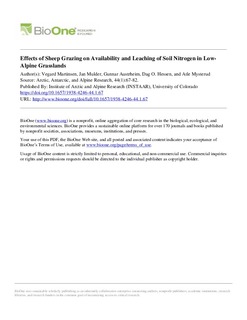| dc.contributor.author | Martinsen, Vegard | |
| dc.contributor.author | Mulder, Jan | |
| dc.contributor.author | Austrheim, Gunnar | |
| dc.contributor.author | Hessen, Dag Olav | |
| dc.contributor.author | Mysterud, Atle | |
| dc.date.accessioned | 2017-11-22T09:23:28Z | |
| dc.date.available | 2017-11-22T09:23:28Z | |
| dc.date.created | 2012-06-04T11:04:16Z | |
| dc.date.issued | 2012 | |
| dc.identifier.citation | Arctic, Antarctic and Alpine research. 2012, 44 (1), 67-82. | nb_NO |
| dc.identifier.issn | 1523-0430 | |
| dc.identifier.uri | http://hdl.handle.net/11250/2467498 | |
| dc.description.abstract | Alpine ecosystems are generally nitrogen (N) limited with low rates of N mineralization. Herbivory may affect N cycling and N losses and thus long-term productivity of ecosystems.
Using a controlled grazing experiment in a low-alpine region at Hol, southern Norway, with three density levels of sheep, we determined effects of grazing on in situ availability of inorganic N, potential N mineralization, and mobility of dissolved inorganic N (DIN) and dissolved organic N (DON) in soil water of O-horizons in grazing-preferred grassland habitats. In addition, we studied the within-season and spatial variation of these processes.
The low alpine grasslands at Hol were characterized by small rates of N mineralization and relatively large plant demands for N. Significantly greater rates of potential N mineralization were found at sites with high sheep density compared to those with low density or no grazing. Effects of grazing on bioavailable N (as determined by buried PRS™ exchange resins) were greater at low as compared to high altitudes. At low altitudes, low sheep density reduced amounts of bioavailable N. Nitrogen concentration of plants as a proxy of N availability in soils revealed, however, no significant effects of grazing. There was a strong seasonal effect on inorganic N and DIN∶DON ratios of the soil water, with decreasing values in the course of the growing season, probably due to increasing nutrient demand of plants and/or microbes.
We conclude that grazing may significantly stimulate N-cycling, but not sufficiently to release the system from its strong N deficiency, as we found no evidence for short-term increased risk in N loss via soil water due to herbivore activity. Nitrogen removal through grazing is small compared to the total soil N pool and at high sheep density is about half of the N deposition. This suggests that grazing in grassland habitats in this low alpine ecosystem is sustainable from a nutrient point of view. | nb_NO |
| dc.language.iso | eng | nb_NO |
| dc.publisher | University of Colorado at Boulder, Institute of Arctic and Alpine Research | nb_NO |
| dc.title | Effects of Sheep Grazing on Availability and Leaching of Soil Nitrogen in Low-Alpine Grasslands | nb_NO |
| dc.type | Journal article | nb_NO |
| dc.type | Peer reviewed | nb_NO |
| dc.description.version | publishedVersion | nb_NO |
| dc.source.pagenumber | 67-82 | nb_NO |
| dc.source.volume | 44 | nb_NO |
| dc.source.journal | Arctic, Antarctic and Alpine research | nb_NO |
| dc.source.issue | 1 | nb_NO |
| dc.identifier.doi | 10.1657/1938-4246-44.1.67 | |
| dc.identifier.cristin | 927602 | |
| dc.relation.project | Norges forskningsråd: 179569 | nb_NO |
| dc.description.localcode | © 2012 University of Colorado at Boulder, Institute of Arctic and Alpine Research | nb_NO |
| cristin.unitcode | 194,31,10,0 | |
| cristin.unitname | Seksjon for naturhistorie | |
| cristin.ispublished | true | |
| cristin.fulltext | original | |
| cristin.qualitycode | 1 | |
